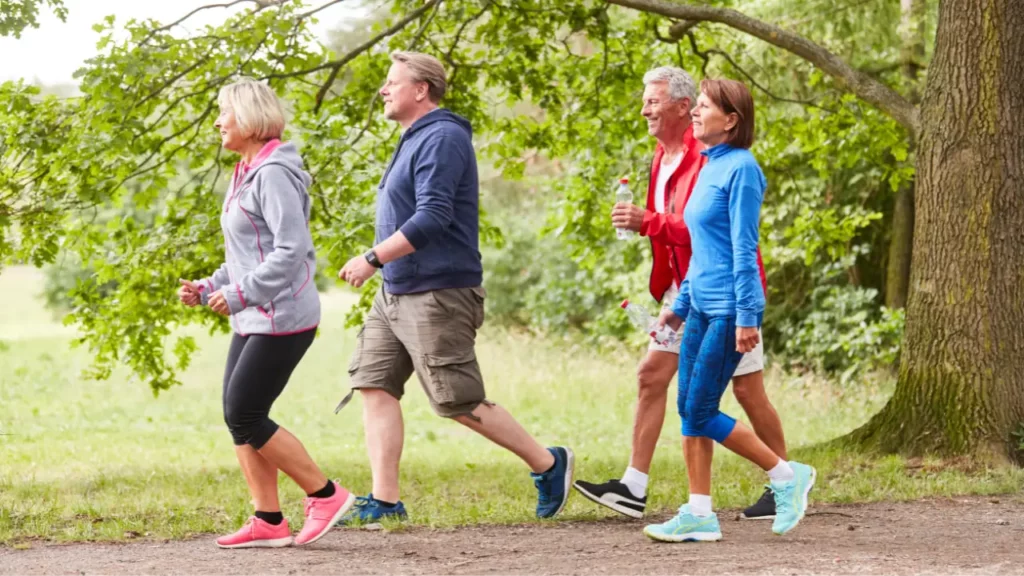Disclaimer: The information provided is for educational and informational purposes only. It is not intended to be a substitute for professional medical advice, diagnosis, or treatment.
Walking, a seemingly modest yet incredibly potent form of exercise, has the power to profoundly influence our well-being. Its simplicity belies its effectiveness, as walking has emerged as a cornerstone in the quest for better health. Among its myriad advantages, walking stands out for its pivotal role in mitigating the risk of diabetes.
In this comprehensive guide, we embark on a journey to uncover the intricate connection between walking pace and diabetes risk, delving into how ramping up your walking speed can serve as a proactive stride towards a healthier lifestyle. Additionally, we will explore how remote patient monitoring can complement and enhance the benefits of brisk walking in diabetes management.
Understanding Diabetes
Before we delve into the benefits of walking, it’s essential to grasp the significance of diabetes. Diabetes mellitus, commonly referred to as diabetes, is a chronic condition characterized by elevated blood sugar levels. Type 2 diabetes, the most prevalent form, often develops due to lifestyle factors such as poor diet and sedentary behavior. Individuals with Type 2 diabetes are at an increased risk of developing various health complications, including heart disease, kidney damage, and nerve damage.
The Role of Walking
Regular physical activity is pivotal in the prevention and management of diabetes. Among the myriad of exercises available, walking stands out as an accessible and low-impact option for individuals of all ages and fitness levels. Studies have consistently demonstrated that engaging in brisk walking can improve insulin sensitivity, lower blood sugar levels, and enhance cardiovascular health.
The Need for Speed: Walking Pace and Diabetes Risk
Recent research has shed light on the importance of walking pace in mitigating the risk of diabetes. While any form of walking is beneficial, studies suggest that picking up the pace can yield even greater health benefits. Walking at a brisk pace, typically defined as 3 to 4 miles per hour, engages more muscles and elevates heart rate, resulting in improved cardiorespiratory fitness and caloric expenditure.
Brisk walking vs. casual strolling
It’s crucial to distinguish between brisk walking and casual strolling when discussing their effects on health. Brisk walking involves maintaining a pace that elevates heart rate and induces mild exertion, whereas casual strolling is characterized by a leisurely pace that does not significantly challenge the body. While both forms of walking offer benefits, research indicates that brisk walking is more effective in reducing diabetes risk and improving overall fitness levels.
Benefits of Increasing Walking Pace
Enhanced cardiovascular health
One of the primary benefits of brisk walking is its positive impact on cardiovascular health. By increasing heart rate and improving blood circulation, brisk walking helps strengthen the heart muscle, lower blood pressure, and reduce the risk of heart disease and stroke.
Improved insulin sensitivity
Insulin sensitivity refers to the body’s ability to respond to insulin effectively, which results in regulating blood sugar levels. Engaging in brisk walking on a regular basis has been shown to enhance insulin sensitivity, making cells more receptive to insulin and reducing the risk of insulin resistance and Type 2 diabetes.
Weight management
Maintaining a healthy weight is essential for diabetes prevention and management. Brisk walking is an effective tool for weight management, as it burns calories and promotes fat loss. By incorporating brisk walking into your daily routine, you can burn excess calories, boost metabolism, and achieve sustainable weight loss.
Mental well-being
In addition to its physical benefits, brisk walking also has a profound impact on mental well-being. Physical activity stimulates the release of endorphins, serotonin, and other neurotransmitters that promote feelings of happiness and relaxation. Regular brisk walking can help alleviate stress, anxiety, and depression, enhancing overall quality of life.
Incorporating Brisk Walking into Your Routine
Setting realistic goals
To reap the benefits of brisk walking, it’s essential to set realistic goals and gradually increase your pace and duration. Start by incorporating short walks into your daily routine and gradually extend the duration and intensity as your fitness improves.
Finding enjoyable routes
Make walking enjoyable by exploring scenic routes, parks, or neighborhoods in your area. Finding a pleasant environment can enhance motivation and make walking a rejuvenating and rewarding experience.
Investing in proper footwear
Invest in a good pair of walking shoes that provide adequate support and cushioning to prevent injury and enhance comfort. Proper footwear is essential for maintaining good posture and preventing foot problems during brisk walking sessions.
Tracking progress
Keep track of your walking progress by using fitness trackers or mobile apps that monitor distance, pace, and calories burned. Tracking your progress provides motivation and accountability, helping you stay committed to your walking routine.
Walk Towards Wellness: Embrace the Power of Brisk Walking
Brisk walking involves maintaining a pace that elevates your heart rate and induces mild exertion. Unlike casual strolling, brisk walking challenges your body and offers numerous health benefits. By incorporating brisk walking into your lifestyle, you can experience enhanced cardiovascular health, improved insulin sensitivity, better weight management, and boosted mental well-being.

Safety Measures and Precautions
- Consultation with healthcare professionals: Individuals with pre-existing health conditions or those new to exercise should consult healthcare professionals before starting a brisk walking
- Proper warm-up and cool-down: Engage in proper warm-up exercises before brisk walking and follow it with a cool-down routine to prevent muscle strains and injuries.
- Hydration and nutrition: Stay hydrated before, during, and after brisk walking sessions, and ensure a balanced diet to support your physical activity levels.
Frequently Asked Questions
What is the recommended walking pace to reduce diabetes risk?
The recommended walking pace to reduce diabetes risk is brisk walking, typically defined as walking at a speed of 3 to 4 miles per hour. This pace elevates heart rate and engages more muscles, leading to improved cardiovascular health and insulin sensitivity.
How does brisk walking lower the risk of diabetes?
Brisk walking lowers the risk of diabetes by improving insulin sensitivity, which allows cells to better respond to insulin and regulate blood sugar levels. Additionally, brisk walking helps manage weight, enhances cardiovascular health, and reduces the likelihood of developing Type 2 diabetes.
What are the benefits of increasing walking pace for diabetes prevention?
Increasing walking pace offers numerous benefits for diabetes prevention, including improved cardiovascular health, enhanced insulin sensitivity, weight management, and better mental well-being. Brisk walking helps lower blood sugar levels, reduce inflammation, and increase energy expenditure, all of which contribute to a reduced risk of diabetes.
How can I incorporate brisk walking into my daily routine?
You can incorporate brisk walking into your daily routine by scheduling regular walks, setting achievable goals, and finding enjoyable routes in your neighborhood or local parks. Start with shorter walks and gradually increase the duration and intensity as you build endurance and confidence.
What type of footwear is recommended for brisk walking?
For brisk walking, it’s essential to wear supportive and comfortable walking shoes that provide adequate cushioning and stability. Investing in proper footwear helps prevent injuries, promotes good posture, and ensures a comfortable walking experience.
How can I track my progress while brisk walking?
You can track your progress while brisk walking by using fitness trackers or mobile apps that monitor distance, pace, and calories burned. Tracking your progress provides motivation, helps you set and achieve goals, and allows you to monitor improvements in your fitness level over time.
Revolutionizing Diabetes Prevention with DrKumo RPM Solution
Innovative approaches to diabetes prevention are crucial in combating the rising prevalence of this chronic condition worldwide. DrKumo’s RPM Solution stands at the forefront of revolutionizing preventative measures, particularly through its emphasis on accelerated walking strategies. By leveraging cutting-edge technologies and evidence-based methodologies, DrKumo’s solution aims to optimize the benefits of walking for individuals at risk of diabetes.
Through personalized guidance and monitoring, this approach not only encourages increased physical activity but also targets specific walking paces proven to effectively reduce diabetes risk factors. With DrKumo’s RPM Solution, individuals can take proactive steps towards better health outcomes and a reduced risk of developing diabetes, thereby fostering a healthier and more resilient population.
Takeaways
Walking at a brisk pace offers a multitude of benefits for overall health and well-being, including a reduced risk of diabetes. By incorporating brisk walking into your daily routine and increasing your pace, you can improve cardiovascular health, enhance insulin sensitivity, manage weight, and boost mental well-being. Take proactive steps towards a healthier future by lacing up your shoes and embracing the power of brisk walking.
Lace up your shoes and stride towards a healthier lifestyle now! Contact us today to learn more about how DrKumo can support your healthcare practice.









